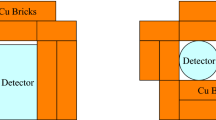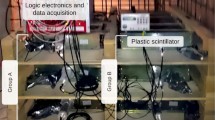Abstract
Rare event search experiments are one of the most important topics in the field of fundamental physics, and high-purity germanium (HPGe) detectors with an ultra-low radioactive background are frequently used for such experiments. However, cosmogenic activation contaminates germanium crystals during transport and storage. In this study, we investigated the movable shielding containers of HPGe crystals using Geant4 and CRY Monte Carlo simulations. The production rates of 68Ge, 65Zn, 60Co, 55Fe, and 3H were obtained individually for different types of cosmic rays. The validity of the simulation was confirmed through a comparison with the available experimental data. Based on this simulation, we found that the interactions induced by neutrons contribute to approximately 90% of the production rate of cosmogenic activation. In addition, by adding an optimized shielding structure, the production rates of cosmogenic radionuclides are reduced by about one order of magnitude. Our results show that it is feasible to use a shielding container to reduce the cosmogenic radioactivity produced during the transport and storage of high-purity germanium on the ground.




Similar content being viewed by others
References
S.M. Bilenky, Neutrinoless double beta-decay. Phys. Part. Nucl. 41, 690–715 (2010). https://doi.org/10.1134/S1063779610050035
K. Zuber, Neutrinoless double beta decay experiments. Acta Physica Polonica. 37, 1905–1921 (2006). https://doi.org/10.1088/1748-0221/1/07/P07002
D.O. Stefano, M. Simone, V. Matteo et al., Neutrinoless double beta decay: 2015 review. Adv. High Energy Phys. 2016, 2162659 (2016). https://doi.org/10.1155/2016/2162659
G. Bertone, The moment of truth for WIMP dark matter. Nature 468, 389–393 (2010). https://doi.org/10.1038/nature09509
J.D. Lewin, P.F. Smith, Review of mathematics, numerical factors, and corrections for dark matter experiments based on elastic nuclear recoil. Astropart. Phys. 6, 87–112 (1996). https://doi.org/10.1016/S0927-6505(96)00047-3
J. Schechter, J. Valle, Neutrinoless double- decay in SU(2)×U(1) theories. Phys. Rev. D. 25, 2951–2954 (1982). https://doi.org/10.1103/PhysRevD.25.2951
D.M. Mei, Z.B. Yin, S.R. Elliott, Cosmogenic production as a background in searching for rare physics processes. Astropart. Phys. 31, 417–420 (2009). https://doi.org/10.1016/j.astropartphys.2009.04.004
K. Kang, J. Cheng, J. Li et al., Introduction to the CDEX experiment. Front. Phys.-Beijing. 8, 412–437 (2013). https://doi.org/10.1007/s11467-013-0349-1
L. Hehn, E. Armengaud, Q. Arnaud et al., Improved EDELWEISS-III sensitivity for low-mass WIMPs using a profile likelihood approach. Eur. Phys. J. C. 76, 548 (2016). https://doi.org/10.1140/epjc/s10052-016-4388-y
R. Agnese, A.J. Anderson, T. Aralis et al., Low-mass dark matter search with CDMSlite. PHYS REV D. 97, 022002 (2018). https://doi.org/10.1103/PhysRevD.97.022002
L. Wang, Q. Yue, K. Kang et al., First results on Ge-76 neutrinoless double beta decay from CDEX-1 experiment. Sci. China Phys. Mech. 60, 071011 (2017). https://doi.org/10.1007/s11433-017-9038-4
R.W. Schnee, D.S. Akerib, M.J. Attisha, et al., The SuperCDMS experiment. In: Klapdor-Kleingrothaus H.V., Arnowitt R. (eds) Dark Matter in Astro- and Particle Physics. Springer, Berlin, pp. 259–268. https://doi.org/10.1007/3-540-26373-X_20
L. Pandola, C. Tomei, GERDA, a GERmanium Detector Array for the search for neutrinoless betabeta decay in 76Ge. AIP Conf. Proc. 842, 843 (2006). https://doi.org/10.1063/1.2220398
N. Abgrall, E. Aguayo, F.T.I. Avignone et al., The MAJORANA DEMONSTRATOR Neutrinoless Double-Beta Decay Experiment. Adv. High Energy Phys. (2014). https://doi.org/10.1155/2014/365432
H. Jiang, L.P. Jia, Q. Yue et al., Limits on light weakly interacting massive particles from the first 102.8 kg × day data of the CDEX-10 experiment. Phys. Rev. Lett. 120, 241301 (2018). https://doi.org/10.1103/PhysRevLett.120.241301
E. Aguayo Navarrete, R.T. Kouzes, A.S. Ankney, et al., Cosmic ray interactions in shielding materials. In: Pacific Northwest National Laboratory Report (2011). https://doi.org/10.2172/1025678
I. Barabanov, S. Belogurov, L. Bezrukov et al., Cosmogenic activation of germanium and its reduction for low background experiments. Nucl. Instrum. Meth. B. 251, 115–120 (2006). https://doi.org/10.1016/j.nimb.2006.05.011
G. Cocconi, V.C. Tongiorgi, Intensity and Lateral Distribution of the N-Component in the Extensive Showers of the Cosmic Radiation. Phys. Rev. 79, 730–732 (1950). https://doi.org/10.1103/PhysRev.79.730
J.F. Ziegler, G.R. Srinivasan, Terrestrial cosmic rays and soft errors. IBM J. Res. Dev. 40, 19–39 (1996). https://doi.org/10.1147/rd.401.0019
J. Tinlot, B. Gregory, Absorption of Penetrating Shower Primaries. Phys. Rev. 75, 519–520 (1949). https://doi.org/10.1103/physrev.75.519
N.Q. Hung, V.H. Hai, M. Nomachi, Investigation of cosmic-ray induced background of Germanium gamma spectrometer using GEANT4 simulation. Appl. Radiat. Isotopes. 121, 87–90 (2017). https://doi.org/10.1016/j.apradiso.2016.12.047
P. Papini, C. Grimani, S.A. Stephens, An estimate of the secondary-proton spectrum at small atmospheric depths. IL Nuovo Cimento C. 19, 367–387 (1996). https://doi.org/10.1007/BF02509295
J. Ma, Q. Yue, S. Lin et al., Study on cosmogenic activation in germanium detectors for future tonne-scale CDEX experiment. Sci. China Phys. Mech. 62, 11011 (2019). https://doi.org/10.1007/s11433-018-9215-0
W.Z. Wei, D.M. Mei, C. Zhang, Cosmogenic activation of germanium used for tonne-scale rare event search experiments. Astropart. Phys. 96, 24–31 (2017). https://doi.org/10.1016/j.astropartphys.2017.10.007
S. Cebrián, J. Amaré, B. Beltrán et al., Cosmogenic activation in germanium double beta decay experiments. J. Phys. Conf. 39, 344–346 (2006). https://doi.org/10.1088/1742-6596/39/1/089
J.J. Back, Y.A. Ramachers, ACTIVIA: Calculation of isotope production cross-sections and yields. Nucl. Instrum. Meth. A. 586, 286–294 (2008). https://doi.org/10.1016/j.nima.2007.12.008
E. Armengaud, Q. Arnaud, C. Augier et al., Performance of the EDELWEISS-III experiment for direct dark matter searches. J. Instrum. (2017). https://doi.org/10.1088/1748-0221/12/08/P08010
H.V. Klapdor-Kleingrothaus, L. Baudis, A. Dietz et al., GENIUS-TF: a test facility for the GENIUS project. Nucl. Instrum. Meth. A. 481, 149–159 (2002). https://doi.org/10.1016/s0168-9002(01)01258-x
F.T. Avignone, R.L. Brodzinski, J.I. Collar et al., Theoretical and experimental investigation of cosmogenic radioisotope production in germanium. Nucl. Phys. B. 28, 280–285 (1992). https://doi.org/10.1016/0920-5632(92)90184-T
W.N. Hess, H.W. Patterson, R. Wallace et al., Cosmic-ray neutron energy spectrum. Phys Rev. 116, 445–457 (1959). https://doi.org/10.1103/PhysRev.116.445
E. Armengaud, Q. Arnaud, C. Augier et al., Measurement of the cosmogenic activation of germanium detectors in EDELWEISS-III. Dark Matter Astro Particle Phys. 91, 51–64 (2017). https://doi.org/10.1016/j.astropartphys.2017.03.006
R. Agnese, T. Aralis, T. Aramaki et al., Production rate measurement of Tritium and other cosmogenic isotopes in Germanium with CDMSlite. Astropart. Phys. 104, 1–12 (2019). https://doi.org/10.1016/j.astropartphys.2018.08.006
Author information
Authors and Affiliations
Corresponding authors
Additional information
This work was supported by the National Key Research and Development Program of China (No. 2017YFA0402203), the National Natural Science Foundation of China (No. 11975162), and the Fundamental Research Funds for Central Universities (No. 20822041C4030).
Rights and permissions
About this article
Cite this article
Yan, YL., Zhong, WX., Lin, ST. et al. Study on cosmogenic radioactive production in germanium as a background for future rare event search experiments. NUCL SCI TECH 31, 55 (2020). https://doi.org/10.1007/s41365-020-00762-1
Received:
Revised:
Accepted:
Published:
DOI: https://doi.org/10.1007/s41365-020-00762-1




